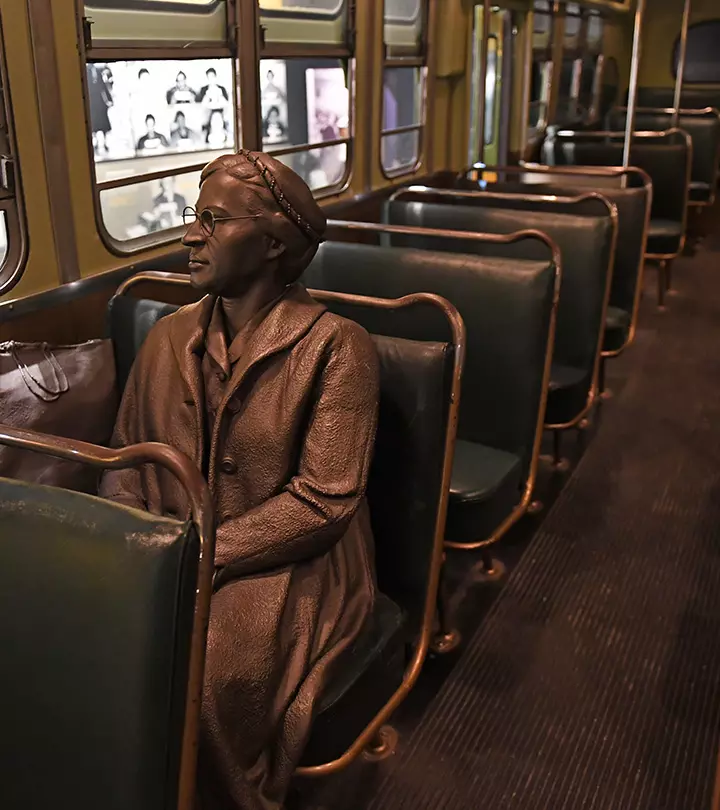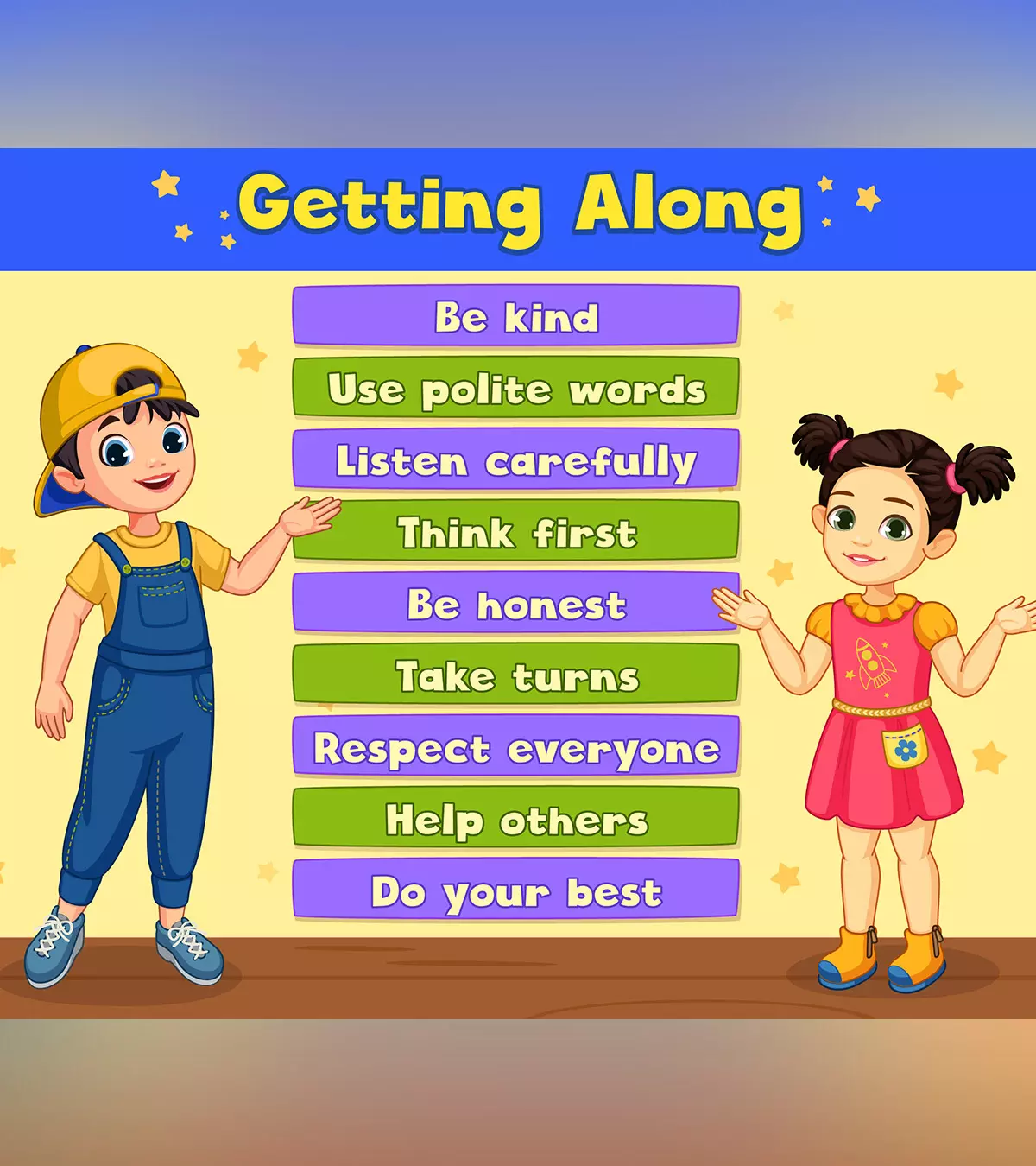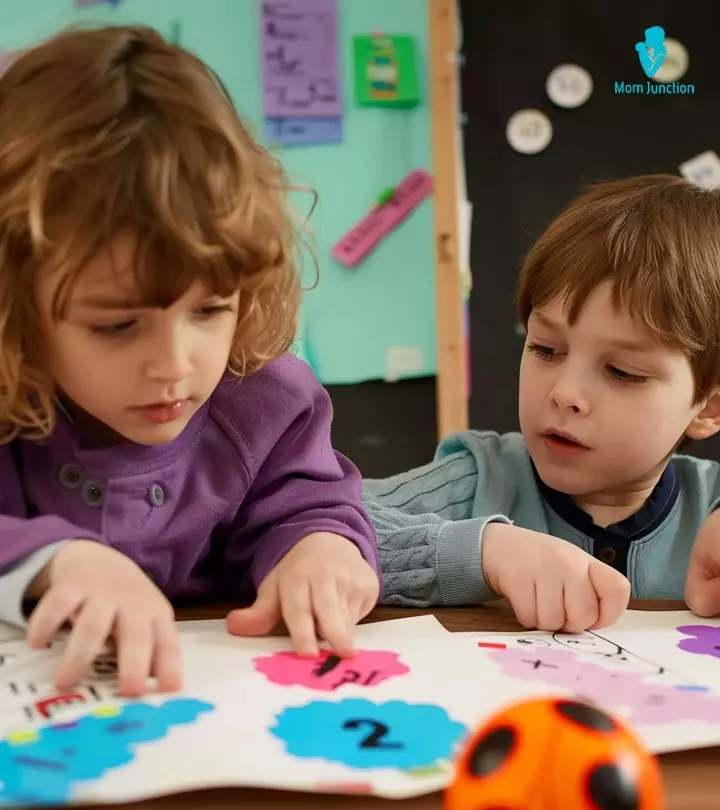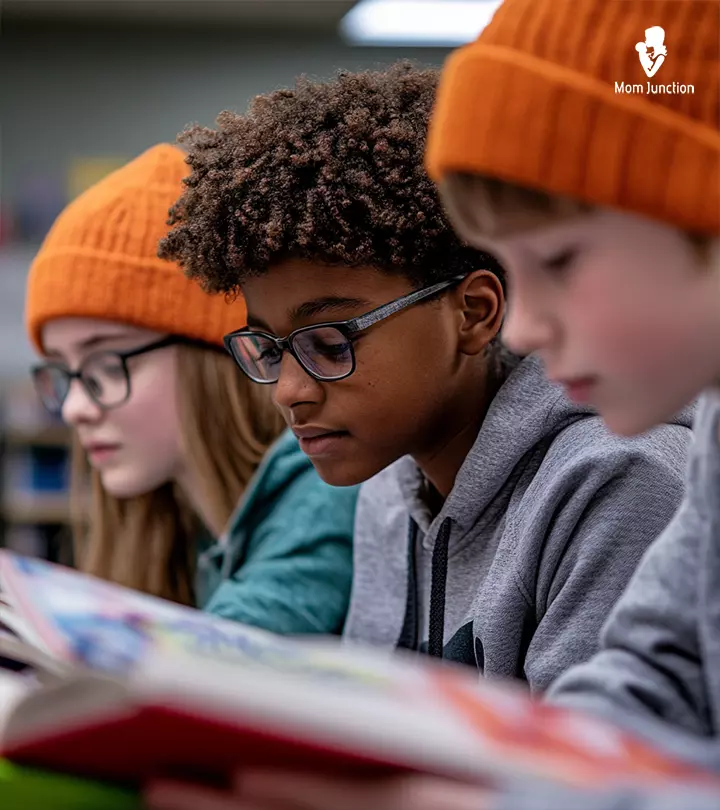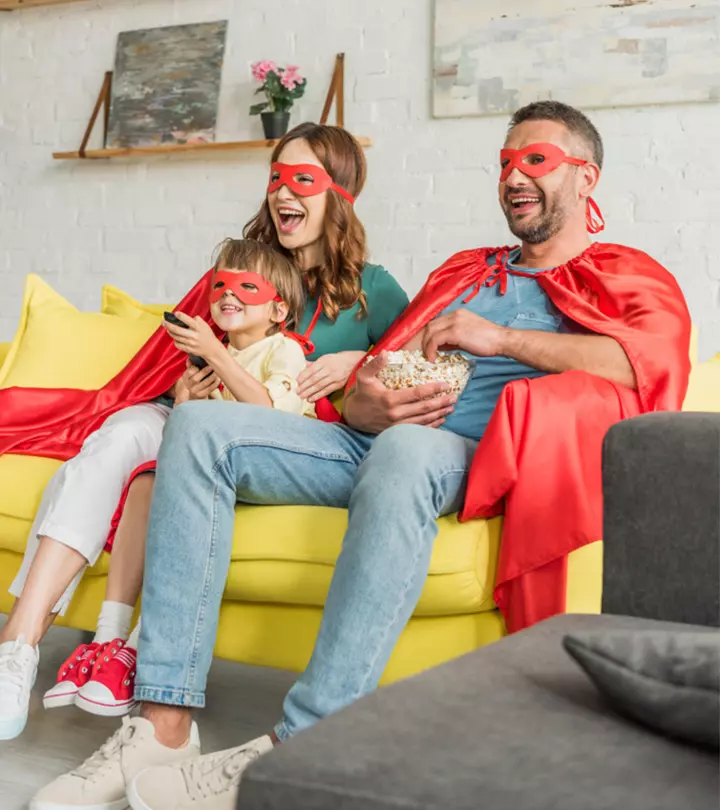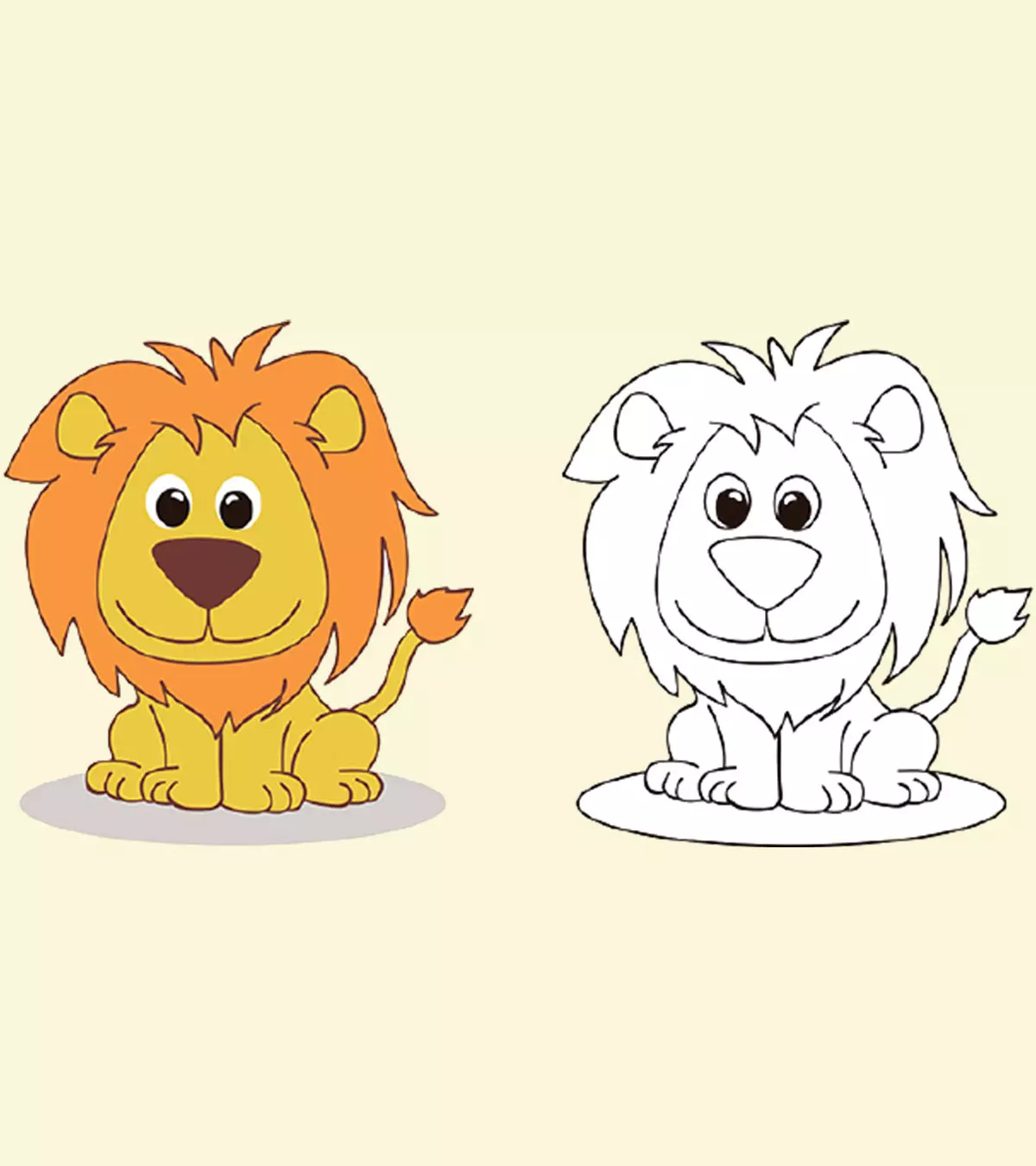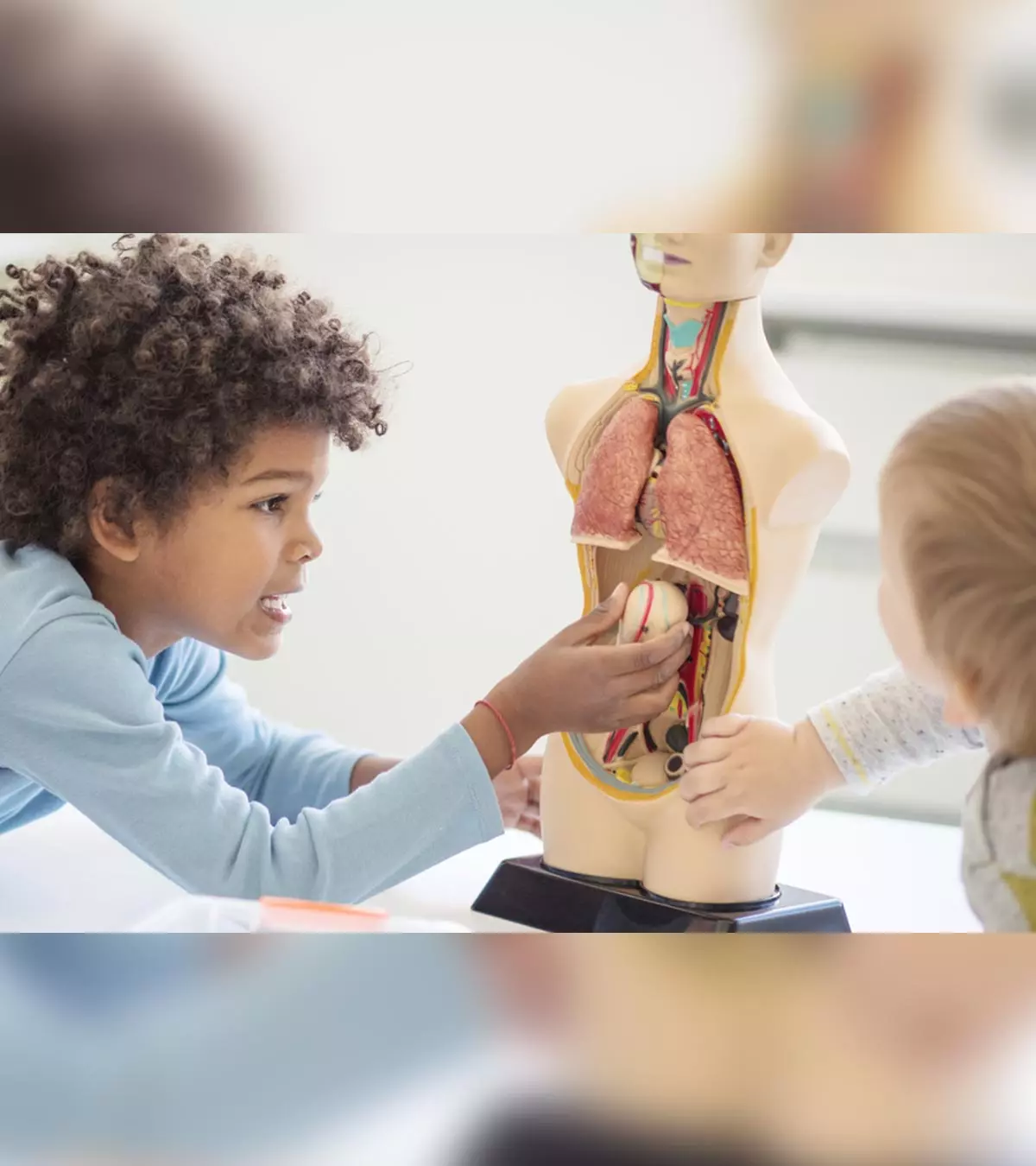
Image: Shutterstock
Children are naturally curious about what their bodies are made of and how they work. To help you quench their thirst for this topic, we bring you some engaging information and fun facts about the human body for kids in this post. Their eagerness and excitement to learn more are absolutely adorable and showcase their keen interest in the subject. The human body is composed of cells that shape into a complex structure. We have curated some more interesting and fun facts to learn about the human anatomy that will both engage and educate your child. Plunge into this post for some fascinating details about the human body and share them with your kid.

Key Pointers
- Teach your child the interesting facts and functions of the human body.
- Knowing about the human body parts and the various functions helps them understand their body better.
- The human body, its senses, organs, and various systems are discussed in this post.
Human Body Parts For Kids
The main structure of a human body
The external part of a human body comprises the head, neck and trunk, forelimbs, and hind limbs. The head and neck house the controlling organ brain that extends throughout the body via the spinal cord. All the important organ systems are located in the neck and trunk. Forelimbs include arms and hands that help grasp, lift, and hold objects. The hind limbs consisting of legs and feet provide mobility to the body (1).
Senses
The human body has five senses, which convey the messages of the outside world to the brain.
The eyes, nose, ears, tongue, and skin are the five sense organs. The senses they perceive are:
- Sight through eyes
- Smell through nose
- Hearing through ears
- Taste through tongue
- Touch through skin
Cells
The fundamental unit of an organism is a cell. The human body has many types of cells. Humans have about 30-37 trillion cells in the body (2). When cells of similar functions accumulate together, they form tissues.
Tissues
A mass of cells specialized in the performance of a particular function forms a tissue. There are four types of tissues (3):
- Epithelial tissues are also known as lining cells. They line the internal parts that come in contact with constituents of the external world. Epithelial cells are observed in the gastrointestinal tractiOrgans responsible for ingestion, digestion, and absorption of food and excretion of the waste. , in the blood capillaries, and the pleuraiThin membrane covering and protecting the lungs and its surrounding cavity. around the lungs. These tissues protect the internal organs and have sensory function
- Connective tissues separate, connect, or support different body tissues and comprise three components: elastic or collagenous fibersiFibrous structures of collagen, a major protein of the connective tissue that provides strength and flexibility. , a gel-like substance in the extracellular matrix, and cells.
- Nervous tissue includes neurons and their supporting cells called neuroglial cells. Neurons generate electrical impulses throughout the body, while neuroglial cells protect neurons.
- Muscular tissues help in the movement of the body. There are three types of muscle tissues:
- Skeletal muscles are attached to bones. They pull the bones when there’s a requirement of movement.
- Smooth muscles are found in blood vessels and all the visceral organsiSoft internal organs of the human body, including the heart, lungs, and the digestive tract. except the heart.
- Cardiac muscles are seen in the heart.
 Quick fact
Quick factOrgans
Tissues with similar functions form an organ. Except for the skin, all organs are located in the body. Heart, liver, and lungs are some examples of organs. Few organs are also found inside cavities. The stomach is present in the abdominal cavity, and the lungs in the thoracic cavity.
Jae, a mother who homeschools her three boys, shares the effective and affordable way in which she taught her young son about the internal body organs. She writes, “We’re doing The Human Body this month and part of which is learning about the basic internal organs of our body… I’ve always wanted to purchase a human torso model to show how these organs look and how they are positioned in the body.
“But the price in this side of the world is not in my budget so what I did was to buy PlayDoh that comes in different colors to create our own model using our Internal Organs Nomenclature Cards… We matched the models with the picture cards. We identified each organ with the labels. As we did this we discussed the many functions and properties of each organ (i).”
Organ systems
Organs and body structures of similar function form organ systems. A human body has 11 organ systems:
1. Skeletal system
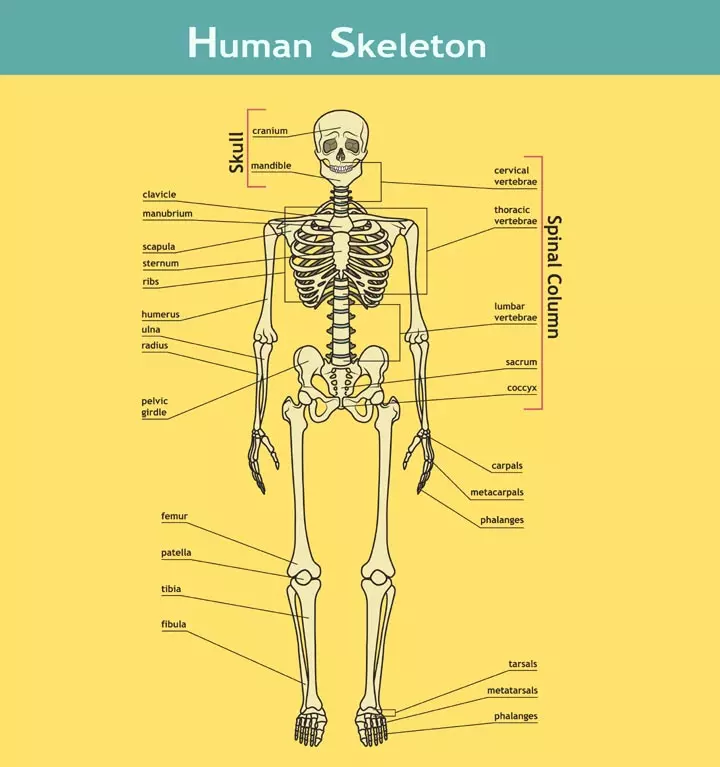
A skeletal system provides the framework to a body and acts as a protective cover for the internal organs. The human skeleton comprises bones, tendonsiStrong fibrous tissues that act as a bridge between muscles and bones and aid in stabilized bone movements. , ligamentsiA connective tissue that connects bones in the joints, providing stability and flexibility. , and cartilageiA connective tissue that provides protection and flexibility to the bones and joints. . Few large bones have a spongy tissue inside them called the bone marrow, where the synthesis of red blood cells takes place. Bones are the major storage site for calcium and phosphorus and are connected by joints. They are responsible for the support and movement of the body. The shape of the bones can be long, short, irregular, or flat.
2. Muscular system
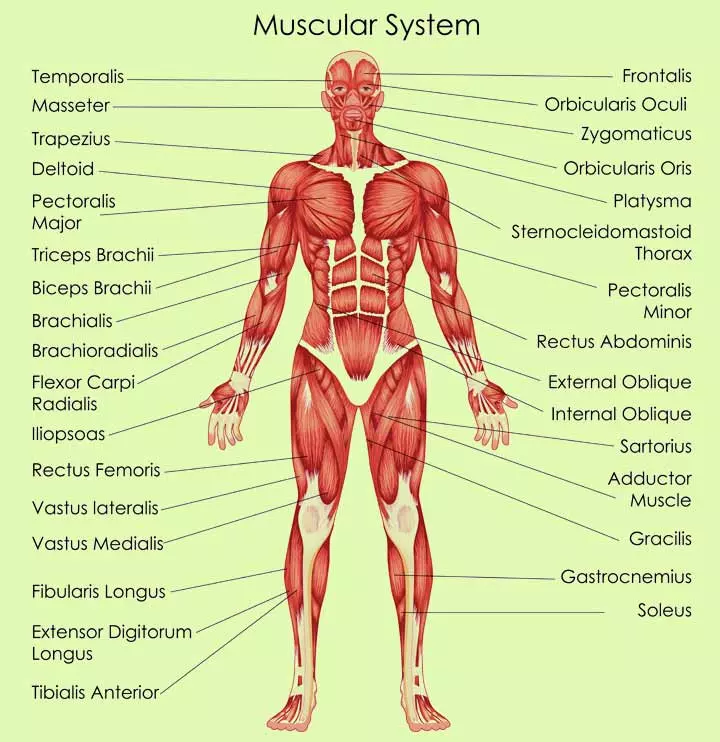
Since the skeletal system and the muscular system usually function together, they are together called the musculoskeletal system. Muscles help in the proper movement of the bones and act as a motor to the body’s movements.
3. Circulatory system
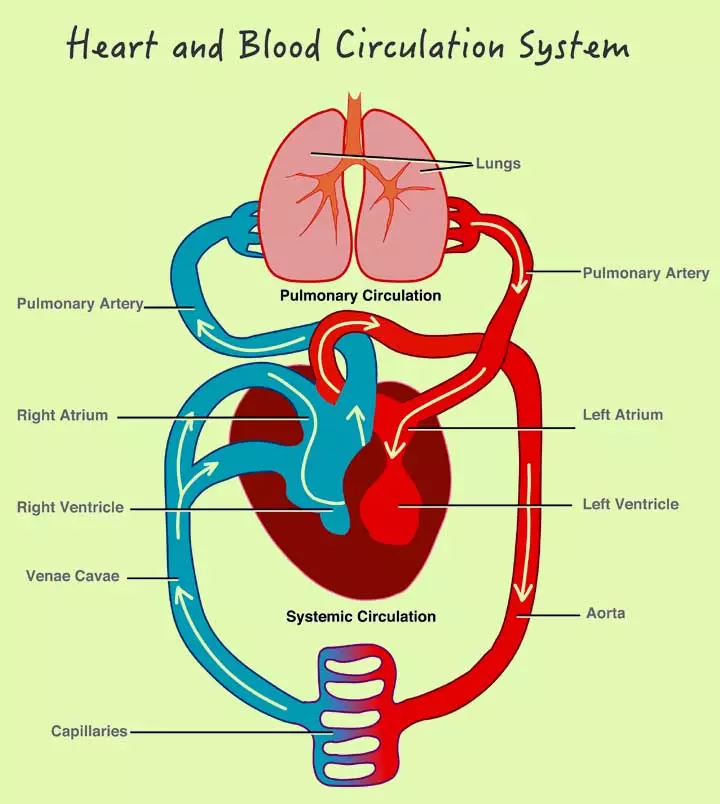
Heart, blood, and blood vessels are parts of the circulatory system.
The blood carries oxygen, nutrients, immune cells, and hormones to multiple organs through its blood vessels, thus becoming the body’s transportation system. Waste products such as carbon dioxide, urea are also carried through the blood.
The heart functions through two circuits. In the pulmonary circuit, the heart transports deoxygenated bloodiOxygen-deficient blood transported through blood vessels called veins to the heart. to the lungs. Here, carbon dioxide (a toxic metabolic waste generated by the human body) is exchanged with the oxygen in the lungs. This oxygenated blood returning to the heart will be pumped to various organs through the systemic circuit.
Arteries, veins, and capillaries are blood vessels. Blood is carried away from the heart through the arteries. Veins carry blood from other parts of the body to the heart. Capillaries are found in the organs, where various metabolic products are exchanged. (4).
4. Digestive system
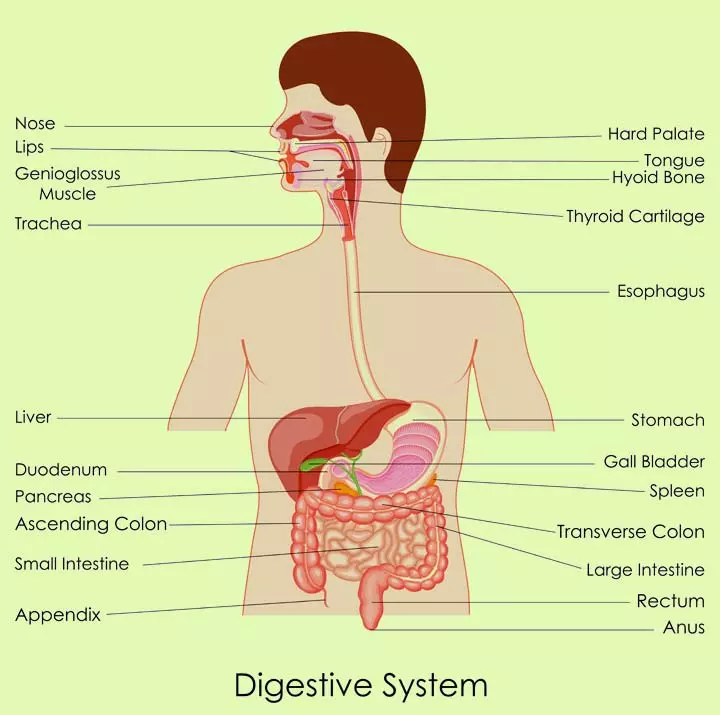
The digestive system carries out the breakdown of the consumed food into nutrients. A series of organs starting from the mouth, esophagus, stomach, small intestine, and large intestine ending in the rectum form the digestive system. The food we consume moves through this sequence with the help of systematic contractions called peristalsis (5). The food we consume through the mouth will pass through the esophagus to the stomach and mix with gastric juices to help digestion. The stomach and small intestine break down the food into smaller molecules such as proteins, fat, sugar, vitamins, and minerals. The small hair-like protrusions on the wall of the small intestine are called the villi and help absorb these nutrients into the bloodstream.
The liver, gallbladder, and pancreas are the accessory digestive organs. The pancreas secretes pancreatic juice, and the liver secretes bile. When food reaches the small intestine, these organs release digestive juices. The gallbladder is a storehouse of bile.
Any undigested food reaches the large intestine, where it is concentrated and excreted as feces on reaching the rectum.
 Did you know?
Did you know?5. Nervous system
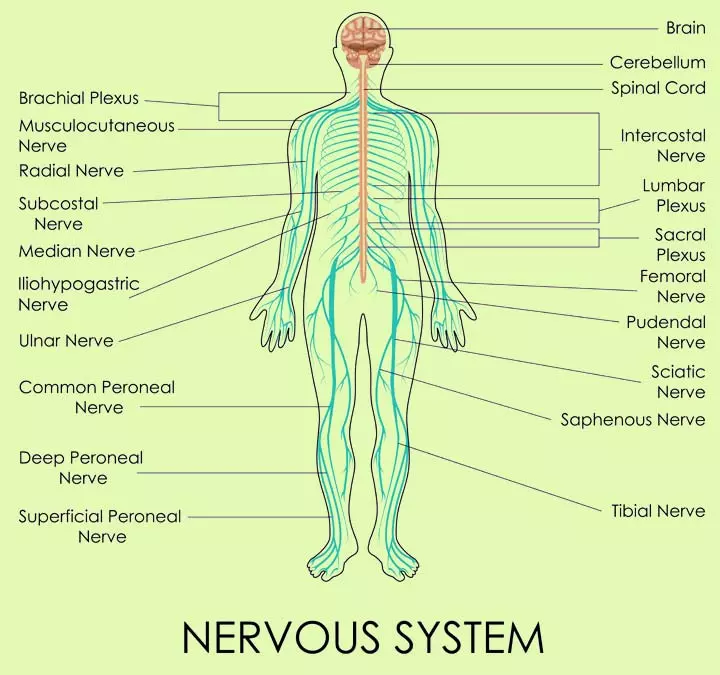
The brain, spinal cord, and related nerves are part of the nervous system. This system allows the human brain to control various parts of the body through its large nerve network (6).
Structurally, the nervous system can be divided into two parts. The Central Nervous System (CNS), consisting of the brain and spinal cord, is responsible for the processing of thought, cognition, and other such functions. The Peripheral Nervous System (PNS) consists of nerves, which are responsible for receiving and transmitting information between the brain and other parts of the body through the sensory and motor neurons.
Functionally, the nervous system is again divided into two parts. The Somatic Nervous System (SNS) is responsible for voluntary actions such as speech. The Autonomic Nervous System (ANS) is responsible for involuntary actions such as digestion, heartbeat, and reflexes.
 Trivia
Trivia6. Respiratory system
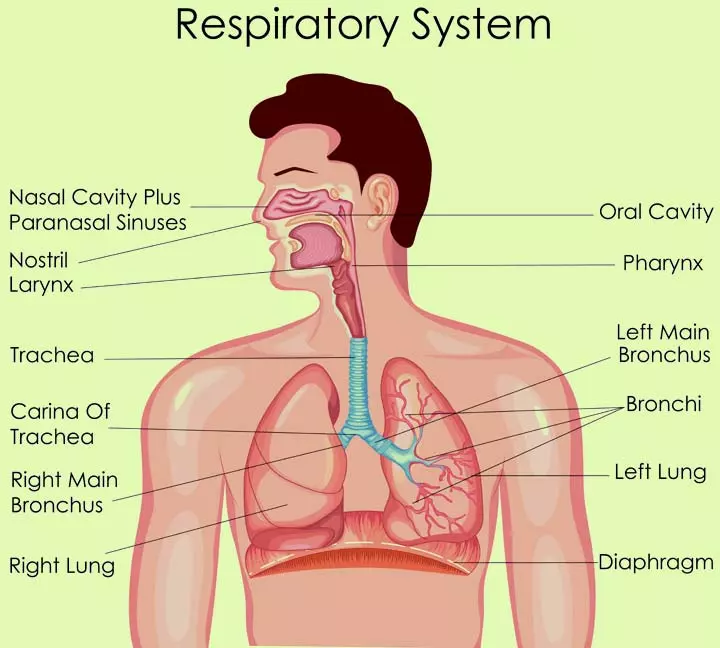
The nose, nasopharynx, trachea, and lungs are parts of the human respiratory system. They take oxygen from the air and release carbon dioxide back into the air. It is located above the diaphragm. The respiration process is divided into two steps —inhalation and exhalation (7).
During inhalation, the diaphragm relaxes, creating a vacuum in the lungs. Due to this, the air is drawn into the trachea and eventually reaches the alveoli, the functional unit of the lungs. Alveoli are tiny air sacs surrounded by a network of capillaries carrying deoxygenated blood. Here, the oxygen in the alveoli is exchanged with the carbon dioxide of the blood capillaries. Now, the oxygenated blood is sent to the heart for distribution throughout the body.
During exhalation, the diaphragm contracts, and the carbon dioxide absorbed from the bloodstream is released back into the air. This is followed by another round of inhalation and exhalation.
 Did you know?
Did you know?7. Endocrine system

An endocrine system comprises glands. They secrete regulatory hormones responsible for human growth, metabolism, and reproduction. The system includes the pituitary gland, adrenal glands, pancreas, thyroid, and gonads. An imbalance in the endocrine system leads to the malfunctioning of the homeostasis of the body. The endocrine hormones are secreted directly into the bloodstream.
8. Urinary system

The kidneys, urinary bladder, and urethra are part of the human urinary system. The waste accumulated in the blood is filtered by the kidneys and excreted through the body as urine.
9. Immune system

The lymphatic system and the immune system work together in protecting the body from external threats. When foreign particles, such as bacteria or viruses, enter the human body, the immune system recognizes them and releases antibodies, cytokinesiSmall signaling proteins that regulate the growth and functioning of blood cells and the immune system. , or macrophagesiSpecialized immune cells that are involved in the recognition and destruction of harmful microbes. for their destruction. The immune system comprises the white blood cells, lymph nodes, lymph channels, tonsils, adenoidsiMass of soft tissues found behind the nasal cavity that help seizes entry of microbes through the nose or mouth. , appendixiA thin tube-like structure present in the lower (right side) region of the abdomen, whose function is not well-distinguished. , spleen, bone marrow, Peyer’s patches, and the thymus gland.
10. Reproductive system
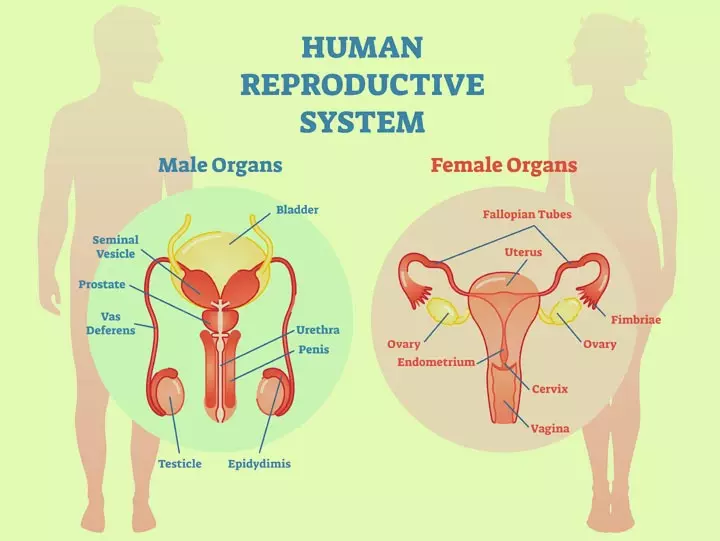
The human male and female reproductive system includes internal and external sex organs. The survival and the population growth of a species depend on the reproductive system. The testes and ovaries are the gonads of males and females, respectively.
The sperm produced by the testes of the male reproductive system fuses with the egg released by the ovaries. This fusion leads to the formation of an embryo, which develops into a fetus in the uterus of the female reproductive system for up to nine months.
11. Integumentary system
All the external protective organs form the integumentary system. These include skin, hair, sweat glands, and nails. They provide structure to the body, protect the internal organs, and act as an interactive medium to the outside world.
Human Body Diagram For Kids
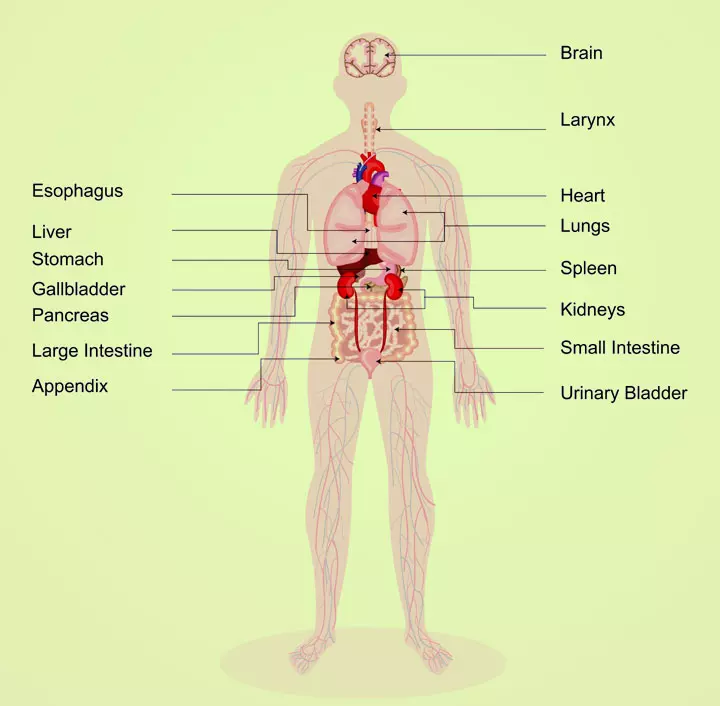
30 Human Body Facts For Kids
Here are a few interesting facts about the human body (2) (8) (9) (10).
- The human blood is composed of red blood cells, white blood cells, platelets, and plasma.
- Up to 60% of the human body is water.
- A human heart beats around 100,000 times in a day. An adult heart beats around 60-80 times per minute, while a child’s heart beats 100 – 120 times.
- Skin is the largest human organ.
- The acid in the stomach is strong enough to dissolve heavy metals.
- To make room for the heart, the left lung is smaller than the right lung.
- At birth, a person has 270 bones. As the individual grows up, few of these bones fuse and reduce to 206 bones in adulthood.
- The electric current generated in the brain is 12-25 watts, which is enough to power LED bulbs.
- Because humans have a spine, they are classified as vertebrates.
- The stapes bone located in the middle ear is only 2.8 millimeters, the smallest bone in the body.
- Digestion starts in the mouth. The saliva consists of an enzyme called salivary amylase, which initiates the digestion process.
- There is hydrochloric acid in the stomach. A mucous lining around the wall of the stomach prevents it from damage.
- There are approximately 25,000 white blood cells in a drop of human blood.
- The movement of the lungs is controlled by the diaphragm. The lungs cannot move by themselves.
- There are more than 600 skeletal muscles that help in various movements of the human body.
- A grown adult normally has a full set of 32 teeth, and the tongue is the strongest muscle in the human body.
- More than a quarter of the oxygen inhaled is consumed by the brain.
- Red blood cells impart color to the blood due to the presence of a red-colored pigment called hemoglobin.
- It takes about 12 hours to digest food completely.
- The heart is the most powerful organ. It can squirt out blood up to a range of nine meters.
- Hands and feet comprise more than half of the bones of the human body.
- The human brain has two hemispheres. The left side of the body is controlled by the right hemisphere, and the right side of the body is controlled by the left hemisphere.
- There are around 200 different types of cells in the human body.
- If the blood vessels of the human body were to be stretched out, they would measure around 60,000 miles in length, enough to wrap around the earth 2.5 times.
- The entire digestive system is 30 feet long.
- A human ear has two functions: hearing and maintaining body balance.
- The integumentary system regulates the body temperature.
- Allergic reactions are the result of the immune response to a compound or substance.
- The lymphatic system is twice larger than the circulatory system.
- In addition to secreting bile for digestion, the liver also metabolizes waste products and is a storehouse of vitamins and minerals.
Human Body Facts: Human Senses
The human senses are fascinating and complex, crucial in how we perceive and interact with the world. Here are some interesting facts about our sensory experiences:
- About 80% of what we perceive as taste is due to our sense of smell (11).
- The human eye can distinguish approximately 10 million different colors (12).
- Humans can hear frequencies between 20 And 20,000 Hz; this range decreases with age (13).
- The fingertips are the most sensitive to touch, having the highest concentration of touch receptors (14).
- Taste buds have a lifespan of about ten days before they are renewed (15).
- Beyond the traditional five, proprioception is considered a sixth sense, indicating the body’s position and movement in space (16).
- The sense of smell is more closely linked to memory than any other sense (17).
Frequently Asked Questions
1. How many parts are in the human body?
According to their position in the body, the human body can be classified into nine parts – the head, neck, chest, abdomen, pelvis, back, hip, extremity, and trunk (18).
2. What is the smallest organ in the human body?
The pineal gland is considered the smallest organ in the human body. This tiny endocrine gland is situated in the middle of the brain. It’s a part of the endocrine system that releases the hormone melatonin and regulates the sleep and wake cycle (19).
3. What is the weakest bone in the human body?
The clavicle or collarbone is considered the softest or weakest bone in the body. According to the experts, “the clavicle is one of the most commonly fractured bones in the human body. It has been reported to represent 2.6 to 4% of all adult fractures (20).”
4. What are some fun ways to make my child learn about the human body parts?
You can make learning more fun by incorporating games like a scavenger hunt, where the child labels different body parts based on hints. You could even help them build a model of the body using clay and ask them to label the parts. Online or offline interactive quizzes after each learning session is another way to make learning about body parts engaging and interesting.
The human body is complex. Hence, to teach body parts to kids and explain their physiology and functions, start by teaching them about the organs, followed by organ systems. Finally, help them understand how the different organ systems of the body function holistically to keep the person healthy. To help you in this task, we have compiled the above post on the human body for kids. We have also included a diagram illustrating the placement of different organs inside the body. With these fun facts and some educational videos on interactive websites, you’ll be able to explain human anatomy to your children with ease.
Infographic: Exciting Human Body Facts That’ll Amaze Children
The human body is a complex structure and network of organs, tissues, and cells. Learning about the human body is always fascinating, especially for children. Here is an infographic with some amazing human body facts you can tell your children. Save and share it with your friends too!
Some thing wrong with infographic shortcode. please verify shortcode syntaxOur human body works in fascinating sync with various organs and systems functioning in tandem. Children can learn some interesting details about human organs from the video provided.
Personal Experience: Source
MomJunction articles include first-hand experiences to provide you with better insights through real-life narratives. Here are the sources of personal accounts referenced in this article.
i. Introducing the internal organs of the body to kids; BlogspotReferences
1. Structural organization of the human body; Openstax
2. How many cells are in the human body; Wonderopolis
3. Types of tissues; Oregon State University
4. How the heart works; Michigan Medicine- University of Michigan
5. Introduction to the digestive system; Libretexts
6. Structure and function of the nervous system; Oregon State University
7. Structure and function of the respiratory system; Libretexts
8. The Water in You: Water and the Human Body; United States Geological Survey
9. 15 interesting facts about human body; Selecthealth
10. Skeletal muscles; Libretexts
11. Bozena B. Wrobel, and Donald A. Leopold; Clinical assessment of patients with smell and taste disorders
12.Reena Mukamal ; How Humans See In Color
13. The Audible Spectrum; National Library of Medicine
14. Rochelle Ackerley et al.; Touch perceptions across skin sites: differences between
15. R Hamamichi et al.; Taste bud contains both short-lived and long-lived cell populations; National Library of Medicine
16. John C Tuthill, and Eiman Azim; Proprioception
17. Rachel S. Herz; The Role of Odor-Evoked Memory in Psychological and Physiological Health
18. Yipei Wang et al.; Mapping anatomical related entities to human body parts based on wikipedia in discharge summaries; BMC
19. Pineal Gland; Cleveland Clinic
20. Steven D. Jones and Jonathan T. Bravman; Midshaft clavicle fractures—when to operate; Anals Of Joints
21. Why Doesn’t Your Heart Get Tired?; Moments of Science
22. Small/Large Intestine Length Ratio; The Center for Academic Research and Training in Anthropogeny
23. When you look up”how many skin cells do we shed a day” you will commonly get an answer of 30,000 to 40,000. How exactly did scientists arrive at this number? What was their method for actually figuring this out?; UCSB Science Line
24. What the nose knows; The Harvard Gazette
Community Experiences
Join the conversation and become a part of our nurturing community! Share your stories, experiences, and insights to connect with fellow parents.
Read full bio of Maria Carmela Villania-Mamauag
Read full bio of Dr Bisny T. Joseph
Read full bio of Harshita Makvana
Read full bio of Shinta Liz Sunny










